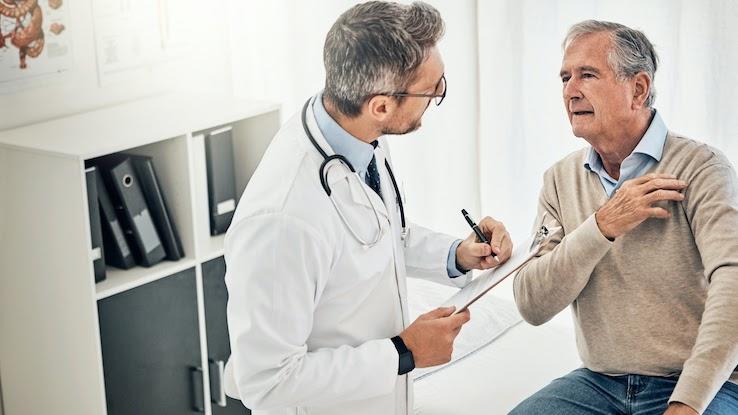Heart Disease 101: Understanding Causes, Symptoms, Diagnosis and Treatment

Heart disease is the leading cause of death in the United States. In fact, 1 in 4 deaths in the United States each year is due to heart disease.
But while heart disease is common, there are steps you can take to lower your risk. And if you already have heart disease, there are treatments that can help you live a longer, healthier life.
Get started understanding the basics of heart disease by learning about symptoms, causes, treatments and what you can do to lower your risk.
What Is Heart Disease?
The heart is a complex muscular organ that pumps blood through your body. It’s located just to the left side of your chest. When your heart beats, it contracts (squeezes) and then relaxes. It relies on electrical impulses to beat properly.
The right side of your heart contains the right atrium and ventricle. These structures collect blood and pump it into your lungs through blood vessels called the pulmonary arteries. The oxygen-rich blood that comes out of your lungs flows back into the left side of your heart. Your heart then pumps this blood through a large artery called the aorta so it can circulate through the rest of your body.
There are many types of heart disease, including coronary artery disease, heart defects, heart infections and problems with heart rhythms. Sometimes heart disease is called cardiovascular disease. Cardiovascular diseases include all heart diseases, along with conditions like stroke and blocked blood vessels.
While heart disease can be very serious, you may be able to successfully treat or even prevent it with simple, healthy lifestyle choices.
Types of Heart Disease

Common forms of heart disease include the following:
- Coronary artery disease happens when blood vessels become narrowed or blocked. This interferes with normal blood flow and can stop the heart, brain and other body areas from getting enough blood.
- Heart arrhythmias are abnormal heartbeat rhythms. This can mean that the heart beats too quickly, too slowly or in an irregular pattern.
- Congenital heart defects are problems with the structure of the heart that happen before birth. Doctors often diagnose major heart defects shortly after birth, but may not find minor heart defects until later in childhood or even adulthood.
- Cardiomyopathy is a condition where the muscle in the heart becomes thick or stiff. Symptoms may not develop until the condition progresses to an advanced stage.
- Heart infections can affect the tissues around or in the heart and can develop at any time.
Symptoms of Heart Disease
Symptoms of heart disease can vary depending on the specific type. General symptoms of heart disease include:
- Chest pain (angina)
- Shortness of breath
- Pain or cold sensation in the arms or legs
- Numbness in the arms
- Weakness in the legs
- Swelling of the legs, ankles or feet
- Fluttering feeling in the chest
- Racing heartbeat (tachycardia) or slow heartbeat
- Lightheadedness, dizziness or fainting
- Tiring quickly or becoming short of breath during activity
- Bloated stomach
- Fatigue (feeling very tired often)
If you notice any of these symptoms, talk with your doctor.
Causes and Risk Factors
There are specific risk factors that increase a person’s chances of developing heart disease. Three important risk factors include:
Heart disease is also more common in older adults and in people who were assigned male at birth.
Other risk factors include:
- Family history of heart disease
- Unhealthy diet
- Lack of exercise
- Other health conditions like diabetes, obesity, chronic stress or problems with dental health
Heart disease has several possible causes — and more than one cause may contribute to a person getting heart disease. Common potential causes include all of the key risk factors above, like smoking, high blood pressure and lack of exercise.
Other factors that can lead to heart disease include:
- Fatty plaque buildup and hardening of the arteries (atherosclerosis)
- Restricted blood flow to organs and tissues
- Drug use
- Heavy drinking
- Stress
- Certain medications, herbal remedies or dietary supplements
Heart defects develop before birth. Some heart defects are genetic, while others can result from certain medical conditions or medicines.
Heart infections can be caused by irritants that enter the heart muscle — like bacteria, viruses, parasites or chemicals. When bacteria enter the bloodstream, they can travel to the heart and cause infection. Regular everyday activities can allow bacteria to enter the bloodstream, such as eating or brushing your teeth.
Diagnosing Heart Disease

There are several diagnostic tests available for diagnosing heart disease. The type of test you need will depend on the type of heart disease your doctor is checking for. Your doctor will perform a thorough physical exam regardless of the type of heart disease you may have.
Your doctor may order blood tests and a chest X-ray. They may also order other tests, including:
- EKG (electrocardiogram) to check for abnormal heart rhythms
- Holter monitoring to continuously record your heart rhythms for 24 hours or more
- Echocardiogram to show your heart’s structure and how well it’s pumping blood
- CT or MRI scans to create detailed pictures of your heart and surrounding structures
These tests are all painless and noninvasive.
In some cases, you may need a cardiac catheterization. In this procedure, your doctor will put a thin tube into a blood vessel and thread it up to your heart. This lets them do more tests, like injecting dye to take more detailed pictures of your heart or taking a heart biopsy (small tissue sample).
Treatment Options
If you’re diagnosed with heart disease, you and your doctor can work together to make a treatment plan. Your treatments will depend on the specific type of heart disease you have. Treatments may include:
- Healthy lifestyle changes
- Medicines
- Medical or surgical procedures
- Medical devices
There’s also a variety of foods that can be effective in treating certain types of heart disease, including flaxseed, oats and omega-3 fatty acids. Just be aware that natural treatments, including foods, may not be right for everyone. It’s important to speak with your doctor before starting treatment with any alternative medicine remedies.
Your Next Steps for Living with Heart Disease

You can significantly improve heart disease — or prevent it in the first place — with some simple lifestyle changes. Try the following steps:
- Quit smoking
- Get more physical activity
- Eat a healthy diet
- Stay at a healthy weight
- Find ways to manage your stress
- Take steps to control your blood pressure and lower your cholesterol
Remember, you can take steps to prevent or manage heart disease. With some healthy changes, you can reverse damage to your heart and live a longer, healthier life.
Resource Links:
- “Heart Disease Facts” via CDC
- “Heart Disease” via Mayo Clinic
- “Primary Prevention of Cardiovascular Disease: A Review of Contemporary Guidance and Literature” via JRSM Cardiovascular Disease
- “Cardiovascular Disease (CVD) and Associated Risk Factors Among Older Adults in Six Low-and Middle-Income Countries” via BMC Public Health





